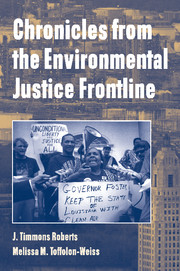Book contents
- Frontmatter
- Contents
- Preface
- 1 Environmental Justice Struggles in Perspective
- 2 Roots of Environmental Injustice in Louisiana
- 3 The Nation's First Major Environmental Justice Judgment: The LES Uranium Enrichment Facility
- 4 EPA's Environmental Justice Test Case: The Shintech PVC Plant
- 5 Media Savvy Cajuns and Houma Indians: Fighting an Oilfield Waste Dump in Grand Bois
- 6 Stress and the Politics of Living on a Superfund Site: The Agriculture Street Municipal Landfill
- 7 The Empire Strikes Back: Backlash and Implications for the Future
- Online Resources on Environmental Justice Struggles
- Suggested Places to Start: A Few Worthwhile Next Readings
- Notes
- References
- Index
1 - Environmental Justice Struggles in Perspective
Published online by Cambridge University Press: 05 July 2014
- Frontmatter
- Contents
- Preface
- 1 Environmental Justice Struggles in Perspective
- 2 Roots of Environmental Injustice in Louisiana
- 3 The Nation's First Major Environmental Justice Judgment: The LES Uranium Enrichment Facility
- 4 EPA's Environmental Justice Test Case: The Shintech PVC Plant
- 5 Media Savvy Cajuns and Houma Indians: Fighting an Oilfield Waste Dump in Grand Bois
- 6 Stress and the Politics of Living on a Superfund Site: The Agriculture Street Municipal Landfill
- 7 The Empire Strikes Back: Backlash and Implications for the Future
- Online Resources on Environmental Justice Struggles
- Suggested Places to Start: A Few Worthwhile Next Readings
- Notes
- References
- Index
Summary
SILENT BATTLEFIELDS IN A FRAGILE LANDSCAPE
Driving along Interstate 10 from east New Orleans to Baton Rouge, the traveler first climbs steeply over the Industrial Canal between the Mississippi River and the Intracoastal Waterway and then drops just as precipitously, rumbling past dingy railroads and industrial land before passing signs for the French Quarter. The Industrial Canal has barges backed up waiting their turn to go through a century-old shipping lock. Today it is the site of a bitter struggle between the U.S. Army Corps of Engineers who want to spend twelve years expanding the lock and residents of the neighborhood who fear it would release toxics from contaminated soils, block traffic, and rattle their homes for over a decade. The predominantly African-American neighborhood claims that choosing to expand the lock rather than siting it in wetlands to the south constitutes environmental racism and has sued the Corps and placed a restraining order to prevent the beginning of the project.
Just past the Canal, off to the left of the highway, is the Agriculture Street Landfill neighborhood, where a middle-class black subdivision was built directly on top of the old city dump in the late 1970s with Federal Housing Authority money. Noxious odors, illnesses, and sinking houses alerted neighbors to the risk, and the Environmental Protection Agency (EPA) put the site on the Superfund “National Priority List” for cleanup in 1994 after conducting soil tests that uncovered 150 toxins in the dirt.
- Type
- Chapter
- Information
- Chronicles from the Environmental Justice Frontline , pp. 1 - 28Publisher: Cambridge University PressPrint publication year: 2001



